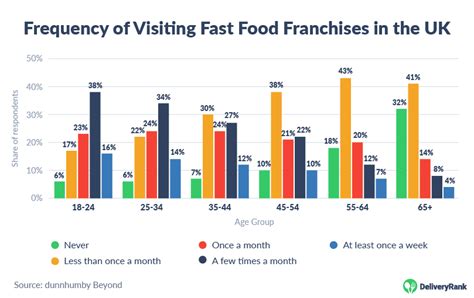
West Virginia leads the United States in fast food consumption, with residents allocating a significant portion of their food budget to quick-service restaurants, according to a recent study by MedicarePlans.com. The study, which analyzed government data and consumer spending habits, reveals that West Virginians spend an average of $1,228 annually on fast food, surpassing all other states.
The analysis examined data related to food spending habits across the United States, revealing a considerable disparity in fast food consumption among different states. West Virginia’s top ranking highlights a potential correlation between socioeconomic factors, access to healthy food options, and lifestyle choices. While the national average expenditure on fast food is substantial, West Virginia’s figures significantly exceed this baseline, raising questions about the underlying causes driving this trend.
The MedicarePlans.com study attributed West Virginia’s high fast-food consumption to several possible factors, including socioeconomic conditions and limited access to healthier alternatives. “West Virginia’s high fast food consumption likely stems from a combination of economic factors, convenience, and accessibility,” said a representative from MedicarePlans.com. The state’s economic challenges, including lower median incomes and higher rates of poverty, may contribute to residents seeking more affordable and readily available meal options. Fast food restaurants often provide lower-cost meals compared to sit-down restaurants or purchasing groceries to cook at home.
Additionally, the study pointed to the prevalence of fast food establishments in West Virginia, particularly in rural areas where access to grocery stores and fresh produce may be limited. This lack of access to healthier food options, sometimes referred to as “food deserts,” can further exacerbate the reliance on fast food as a primary source of nutrition. The geographical landscape of West Virginia, characterized by mountainous terrain and dispersed communities, also poses logistical challenges for the distribution of fresh food, making fast food a more convenient choice for many residents.
The implications of West Virginia’s high fast-food consumption extend beyond mere dietary preferences. Public health officials express concern that the state’s reliance on fast food contributes to higher rates of obesity, heart disease, diabetes, and other chronic health conditions. These health issues place a significant burden on the state’s healthcare system and can lead to decreased quality of life for individuals affected.
Moreover, the economic impact of health-related issues linked to fast food consumption can further strain the state’s resources, creating a cycle of economic hardship and health disparities. Addressing this issue requires a multi-faceted approach that includes promoting healthier eating habits, increasing access to affordable and nutritious food, and implementing policies that support healthy lifestyles.
The study highlighted other states with high fast-food consumption, including Mississippi, Alabama, Louisiana, and Kentucky. These states share similar socioeconomic characteristics with West Virginia, such as lower median incomes and higher rates of poverty, suggesting a possible link between economic factors and dietary choices. Mississippi ranked second with an average annual fast-food expenditure of $1,207, followed closely by Alabama at $1,181. Louisiana and Kentucky also exceeded the national average, indicating a broader trend of higher fast-food consumption in the Southern United States.
Conversely, states with lower fast food consumption tended to be those with higher median incomes and greater access to healthier food options. These states often have more robust public health programs and policies aimed at promoting healthy eating habits. The data suggests that addressing the issue of fast-food consumption requires a comprehensive approach that considers both individual choices and systemic factors.
The MedicarePlans.com study serves as a call to action for policymakers, public health officials, and community organizations to address the underlying factors contributing to West Virginia’s high fast-food consumption. Possible interventions include implementing policies that incentivize healthier food options, providing nutrition education programs, and addressing the economic challenges that limit access to affordable and nutritious food. By working together, stakeholders can create a healthier food environment and improve the well-being of West Virginia residents.
The study’s findings have sparked debate among health experts and policymakers regarding the most effective strategies for addressing the issue of fast-food consumption. Some argue that focusing on individual responsibility and education is the key, while others emphasize the need for systemic changes that address the root causes of food insecurity and limited access to healthy options.
One approach is to implement policies that make healthier food options more affordable and accessible. This could include providing subsidies for farmers markets and community gardens, incentivizing grocery stores to locate in underserved areas, and implementing taxes on unhealthy foods and beverages. Another strategy is to promote nutrition education programs in schools and communities, teaching individuals how to make informed food choices and prepare healthy meals.
Furthermore, addressing the economic challenges that contribute to food insecurity is crucial. This could involve raising the minimum wage, expanding access to job training and employment opportunities, and providing social safety net programs that help low-income families afford nutritious food. By addressing these systemic factors, policymakers can create a more equitable food environment that supports the health and well-being of all residents.
The long-term impact of West Virginia’s high fast-food consumption on the state’s economy and public health remains a significant concern. Without intervention, the state risks facing even higher rates of chronic disease, increased healthcare costs, and reduced productivity. By taking proactive steps to address the issue, West Virginia can improve the health and economic prospects of its residents and create a more sustainable future.
The study also examined the nutritional content of fast food meals and found that many options are high in calories, fat, sodium, and sugar. Regular consumption of these foods can contribute to weight gain, high blood pressure, high cholesterol, and other health problems. The study emphasized the importance of making informed food choices and limiting the consumption of fast food.
The findings of the MedicarePlans.com study underscore the need for a comprehensive approach to addressing the issue of fast-food consumption in West Virginia. This approach should involve collaboration among policymakers, public health officials, community organizations, and individuals to create a healthier food environment and promote healthy lifestyles. By working together, stakeholders can make a meaningful difference in the health and well-being of West Virginia residents.
The study also acknowledged that cultural factors may play a role in fast-food consumption. In some communities, fast food restaurants may be seen as social gathering places or symbols of convenience and modernity. Understanding these cultural factors is important for developing effective interventions that resonate with local communities.
The report further noted that the fast food industry spends billions of dollars each year on marketing and advertising, often targeting children and low-income communities. These marketing efforts can influence food preferences and consumption patterns, making it more difficult for individuals to make healthy choices. The study suggested that policies aimed at regulating fast food advertising could help to reduce its impact on public health.
In addition to the health implications, the study also touched upon the environmental impact of fast food consumption. The production and transportation of fast food ingredients can contribute to greenhouse gas emissions, deforestation, and other environmental problems. Reducing fast food consumption can help to mitigate these environmental impacts.
The research also revealed that fast food workers often face low wages, limited benefits, and challenging working conditions. Supporting policies that improve the working conditions of fast food workers can help to create a more equitable and sustainable food system.
The study concluded by emphasizing the importance of ongoing research and monitoring to track trends in fast food consumption and evaluate the effectiveness of interventions aimed at promoting healthier eating habits. By staying informed and adapting strategies as needed, policymakers and public health officials can continue to make progress in improving the health and well-being of West Virginia residents.
Further analysis of the data revealed a correlation between education levels and fast-food consumption, with individuals with lower levels of education being more likely to consume fast food regularly. This suggests that education plays a crucial role in shaping food choices and promoting healthy eating habits.
The study also examined the role of government policies in influencing fast-food consumption. Policies such as soda taxes, menu labeling requirements, and restrictions on fast food advertising can all have an impact on consumer behavior. The effectiveness of these policies varies depending on the specific context and implementation.
The research highlighted the importance of community-based interventions in addressing the issue of fast-food consumption. These interventions can include initiatives such as community gardens, farmers markets, cooking classes, and nutrition education programs. By engaging local communities, these interventions can be tailored to meet the specific needs and preferences of residents.
The study also explored the role of technology in promoting healthier eating habits. Mobile apps, online resources, and social media can all be used to provide individuals with information and support to make informed food choices. These technologies can also be used to track food consumption and provide personalized feedback.
The report further noted the importance of addressing the social and emotional factors that can contribute to unhealthy eating habits. Stress, boredom, and emotional distress can all lead to overeating and the consumption of unhealthy foods. Strategies for managing stress and promoting emotional well-being can help individuals to make healthier food choices.
The study also acknowledged the role of the food industry in promoting healthier eating habits. Food manufacturers and restaurants can take steps to reduce the amount of salt, sugar, and fat in their products and offer more nutritious options. By working collaboratively, the food industry and public health officials can create a healthier food environment for all.
The research concluded by emphasizing the need for a long-term commitment to addressing the issue of fast-food consumption. This requires ongoing investment in research, education, and policy initiatives. By working together, stakeholders can create a healthier and more equitable food system that supports the health and well-being of all West Virginia residents. The complexity of this issue requires a nuanced approach that acknowledges the interplay of economic, social, cultural, and environmental factors.
The findings of the MedicarePlans.com study align with previous research on food deserts and health disparities, further solidifying the connection between socioeconomic factors and dietary choices. The study reinforces the importance of addressing systemic inequities to improve public health outcomes.
The report also touched on the role of transportation infrastructure in influencing food access. In rural areas with limited public transportation, residents may have difficulty accessing grocery stores and other sources of healthy food. Improving transportation infrastructure can help to address this issue.
The study highlighted the importance of partnerships between healthcare providers and community organizations in promoting healthier eating habits. Healthcare providers can play a role in educating patients about nutrition and providing referrals to community-based resources.
The research also explored the potential of telemedicine to improve access to nutrition counseling and other health services in rural areas. Telemedicine can overcome geographical barriers and make it easier for residents to access the care they need.
The report further noted the importance of addressing the stigma associated with food insecurity. Many individuals who struggle to afford nutritious food are reluctant to seek help due to shame or embarrassment. Creating a more supportive and understanding environment can encourage individuals to access the resources they need.
The study also acknowledged the role of the media in shaping public perceptions of food and nutrition. Media coverage of food-related issues can influence consumer behavior and promote healthier eating habits.
The research concluded by emphasizing the need for a collaborative and multidisciplinary approach to addressing the issue of fast-food consumption. This requires the involvement of policymakers, public health officials, community organizations, healthcare providers, educators, and the food industry. By working together, stakeholders can create a healthier and more equitable food system for all.
The findings of this study are particularly relevant in the context of the ongoing COVID-19 pandemic, which has exacerbated existing health disparities and food insecurity issues. The pandemic has highlighted the importance of ensuring that all individuals have access to affordable and nutritious food.
The report also touched upon the role of urban planning in promoting healthier eating habits. Urban planners can design communities that are more walkable and bikeable, making it easier for residents to access grocery stores and other sources of healthy food.
The study highlighted the importance of empowering communities to take control of their food systems. This can involve supporting local farmers, creating community-owned grocery stores, and promoting food sovereignty.
The research also explored the potential of using behavioral economics to encourage healthier eating habits. Behavioral economics principles can be used to design interventions that nudge individuals towards making healthier choices.
The report further noted the importance of addressing the root causes of poverty and inequality to improve food security and public health. Policies that promote economic opportunity and reduce disparities can have a significant impact on dietary choices.
The study concluded by emphasizing the need for a holistic approach to addressing the issue of fast-food consumption. This approach should consider the interconnectedness of economic, social, cultural, environmental, and health factors. By working together, stakeholders can create a healthier and more equitable food system for all West Virginia residents.
Frequently Asked Questions (FAQs):
1. Why does West Virginia have such high fast-food consumption compared to other states?
- According to the MedicarePlans.com study, West Virginia’s high fast food consumption is likely due to a combination of economic factors, convenience, and accessibility. The state’s economic challenges, including lower median incomes and higher rates of poverty, may contribute to residents seeking more affordable meal options. Additionally, the prevalence of fast-food establishments, particularly in rural areas with limited access to grocery stores and fresh produce, exacerbates the reliance on fast food as a primary source of nutrition.
2. What are the potential health risks associated with high fast-food consumption?
- Public health officials are concerned that West Virginia’s reliance on fast food contributes to higher rates of obesity, heart disease, diabetes, and other chronic health conditions. The study emphasized that many fast-food options are high in calories, fat, sodium, and sugar, and regular consumption of these foods can lead to weight gain, high blood pressure, high cholesterol, and other health problems.
3. What can be done to address the issue of high fast-food consumption in West Virginia?
- The MedicarePlans.com study suggests a multi-faceted approach is needed to address West Virginia’s high fast-food consumption. Possible interventions include implementing policies that incentivize healthier food options, providing nutrition education programs, and addressing the economic challenges that limit access to affordable and nutritious food. Promoting community-based interventions, such as community gardens and cooking classes, can also help.
4. Are there other states with similar fast-food consumption patterns as West Virginia?
- Yes, the study highlighted other states with high fast-food consumption, including Mississippi, Alabama, Louisiana, and Kentucky. These states share similar socioeconomic characteristics with West Virginia, such as lower median incomes and higher rates of poverty, suggesting a possible link between economic factors and dietary choices.
5. What role does the fast-food industry play in influencing consumption habits in West Virginia?
- The study acknowledges that the fast-food industry spends billions of dollars each year on marketing and advertising, often targeting children and low-income communities. These marketing efforts can influence food preferences and consumption patterns, making it more difficult for individuals to make healthy choices. The study suggested that policies aimed at regulating fast-food advertising could help to reduce its impact on public health.









